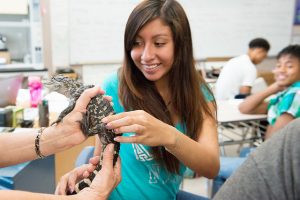Roosevelt Becomes Blank Park Zoo Outpost for a Day
There’s always a lot of life at Roosevelt High School, just not in quite so many forms as on Tuesday morning.
In one upstairs environmental science classroom Noreen Nsereko and her students welcomed a menagerie of guests from the Blank Park Zoo. Mingling with the human teens indigenous to Room 2250 were a cane toad, a macaw, a handheld juvenile alligator and, most impressively, an eight-foot, 35 pound snake. When “Jersey” the boa constrictor was lifted from her transport cooler it looked like her handlers were lugging a rolled up rug on moving day. She had little to say, unlike “Amboro,” the finely feathered blue and gold rain forest macaw who was happy to wave, flex, repeat his name and do impressions of his distant cousin the chicken upon request; anything for a treat.
The visiting wildlife decorated and facilitated a broader class discussion about endangered habitats and species. But the fragile, teetering, tottering balance of life on earth was perhaps more vividly demonstrated down the hall in Room 2310 where biology teacher Deb Henry’s classes have been sending monarch butterflies winging to Mexico on a daily basis since school started last month.
Colleagues of Henry harvested eggs from milkweed plants in their yards over the summer. The eggs hatched into caterpillars or larvae which transformed into the pupal or chrysalis stage. Each day several more adult monarchs emerge and tentatively flex the intricate wings being fueled by fluids pumped up from the abdomen. Then they’re gently bagged in a mesh carrier and escorted downstairs for release. Students place the butterflies on bushes outside the school’s main entrance. Tuesday morning a few immediately took off. A few others let them have a headstart on the long journey ahead. There are more where today’s squadron came from. Many chrysalises remain in Henry’s classroom.
Every year sees several generations of monarchs. Each of them except this last one lives no more than a matter of weeks. But the autumn monarchs are built to last, relatively speaking, though you’d never think so to look at them. Somehow they fly up to 3,000 miles to winter in Mexico where they are rewarded with a nice stay in exchange for their yeoman’s service to their species. In early spring they mate and die.
Once plentiful during the summertime in Iowa, monarchs are scarcer now due to eradication of milkweed, the official and exclusive nursery for monarch eggs. The larvae are picky eaters. If you see any grownups fluttering about the pretty Roosevelt campus in the autumn days to come, point them south, wish them well and wonder: Are they the last generation of the Class of 2014 or the first generation of the Class of 2015? Either way they’ve graduated and it’s time to go.
Video of Zoo’s Visit to Roosevelt
Photos of Zoo’s Visit to Roosevelt
Created with flickr slideshow.





